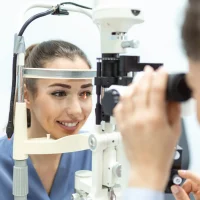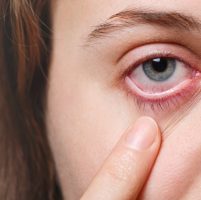Cornea
The cornea is the clear front window of the eye that covers the colored iris and the round pupil. Light is focused while passing through the cornea so we can see. The Alta Vista Eye Clinic has many corneal surgical options that work with the cornea. Schedule an appointment to learn more, and all your questions answered in regards to Cornea health.
Pterygium Treatment and Surgery
A pterygium is a growth on the clear layer of the eye which can spread to the cornea. If the pterygium is irritating or causing visual problems, a surgical graft can be performed to treat it. Alta Vista Eye Clinic offers other options to treat a pterygium as well. A pterygium can be removed for cosmetic purposes too.
Cornea Surgery
Pterygium is a benign growth of the conjunctiva (a layer over the white part of the eye) that grows into the cornea (the clear layer over the colored part of the eye). A pterygium usually begins at the nasal side of the eye, but it can also occur on the lateral side, or both. It can be different colors; sometimes yellow, white or pink.
Patients with pterygium often first notice the condition because of a focal dry, itchy irritation, or redness. A pterygium is usually first discovered when it is confined only to the conjunctiva. At this early stage, it is called a pingueculum. Once it actually extends to the cornea it is properly termed a pterygium and can eventually lead to impaired vision. A pterygium can cause astigmatism (irregular curvature of the eye), and if left untreated, can grow into the pupil and block the visual axis.
What Are The Causes Of Pterygium?
Although the causes of pterygium are not entirely known, it is believed to be caused mainly by exposure to UV light. Another major risk factor is living in a dry, dusty, windy environment. People who live near the equator or participate water sports such as surfing and fishing are thus more likely to develop a pterygium. Prolonged exposure to these conditions causes the conjunctiva to thicken and the eye to become red and inflamed. As a result of this inflammation, collagen in the eye begins to change and a pterygium forms.
Studies show that there may also be a genetic predisposition to pterygium, with a higher prevalence in men than in women.
Pterygium Treatment Options We Offer
In most mild cases of pterygium, artificial tears can be used to reduce dryness and inflammation. Other anti-inflammatory eye drops can be prescribed by your ophthalmologist to reduce flare-ups.
For patients with severe cases whose vision has been affected, different types of surgery are available. Surgery is the only way to definitively remove a pterygium, but it is not a perfect solution; it requires long-term follow-up, and there is always a risk that the pterygium will grow back. The currently preferred methods of pterygium excision are:
- Conjunctival autografting is a safe and effective technique that surgically removes a pterygium and reduces the chance of recurrence. In this procedure, the pterygium over the cornea is removed along with the base of abnormal conjunctival tissue covering the sclera. This tissue over the sclera is replaced with a patch of transplanted tissue from the part of the conjunctiva that is protected by the upper eyelid (the autograft). This autograft is secured with either tiny absorbable sutures or tissue adhesive.
- Amniotic membrane transplant is used either as a primary procedure if the size of the pterygium too large for an autograft, or if a prior attempt at conjunctival autograft had failed. This procedure uses amniotic membrane (which is the lining of the human placenta), to provide enough coverage of a defect that would be created by excising a large pterygium. This technique is often very successful in the most severe cases.
Corneal ulcers and treatments
A corneal ulcer is an open sore on the cornea—the transparent front surface of the eye. It is often caused by infections (bacterial, viral, fungal, or parasitic) but can also result from trauma, contact lens misuse, or severe dry eye.
Corneal Infection Treatments
The cornea is a thin, clear, spherical layer of tissue on the surface of the eye that provides a window for light to pass through. In a healthy eye, the cornea bends or refracts light rays so they focus precisely on the retina in the back of the eye.
There are many diseases that can affect the cornea, causing pain or loss of vision. Disease, infection or injury can cause the cornea to swell (called “edema”) or degrade (become cloudy and reduce vision).
OUR SERVICES
CATARACTS
Restore your vision and reclaim your life with our expert cataract services. Experience clearer sights with personalized care and advanced technology!
RETINA
Safeguard your vision with our advanced retina services. From diagnosis to treatment, we’re here to help protect and restore your sight!
DRY EYE
Find relief from dry eye discomfort with our comprehensive care solutions. Rejuvenate your eyes and restore comfort for clearer, brighter vision!
NEAR VISION
Enhance your near vision with our tailored solutions for reading and close-up tasks. Experience the joy of clear details and effortless focus!
GLAUCOMA
Stay ahead of glaucoma with our specialized screening and treatment options. Preserve your vision with early detection and expert care!
EYE DISEASE
Protect your vision with our expert eye disease management services. Early detection and personalized treatment can make all the difference—schedule your consultation today!
Hordeolum
Styes (hordeola) and chalazia are commonplace eyelid conditions that cause swelling but fluctuate in purpose and symptoms.
Blepharitis
Blepharitis influences extra than eighty two million humans within the United States, with many experiencing more than one episodes within the direction of their lifetime.
Catch on
Patient Portal
Stay connected to your care with our easy-to-use Patient Portal.
Find Our
EYE CARE CENTER
Visit our two state-of-the-art clinics in California, designed to best meet your needs.
Financial
ARRANGEMENT
Alta Vista Eye Care accepts a wide range of insurance plans and provides flexible patient financing options to assist with out-of-pocket expenses. Our dedicated financial counselors are here to guide you through the approval process, which takes just minutes!
What Our Clients Say
Trustindex verifies that the original source of the review is Google. I felt that the doctor was interested in me and was helpfulTrustindex verifies that the original source of the review is Google. Excellent service.Trustindex verifies that the original source of the review is Google. The staff and the doctor were the best.. very caring and knowledgeable. Excellent careTrustindex verifies that the original source of the review is Google. As always the service is perfect I love the staff and the doctor is awesomeTrustindex verifies that the original source of the review is Google. The doctors and staff at his office are exceptional in their field. After one trip to the emergency room, one trip to their office. Still feeling pain from what I believe before an object in my eye, they saw me at the end of their day. They all stayed late and a foreign object was removed from my eye.If you want, exceptional care, kindness, and highly educated doctors and staff. I would highly recommend this office to anybody looking for an ophthalmologist that is exceptional and an exceptional office staff I can’t thank them enough for the kindness and relief they’ve given meTrustindex verifies that the original source of the review is Google. Buen servicio muy buena atención y muy.buenos.especialista en la vista cataratas carnosidad glucomaTrustindex verifies that the original source of the review is Google. ExcellentTrustindex verifies that the original source of the review is Google. The Dr and his team members are very helpful and caring for their patients. I will recommend them to my friends and relatives. Thank you.
LOCATIONS
1901 Outlet Center Drive Suite 240
Oxnard, CA 93036
Tel 805-981-6300
1000 Newbury Road
Suite 230
Thousand Oaks, CA 91320
Tel 805-499-6800









